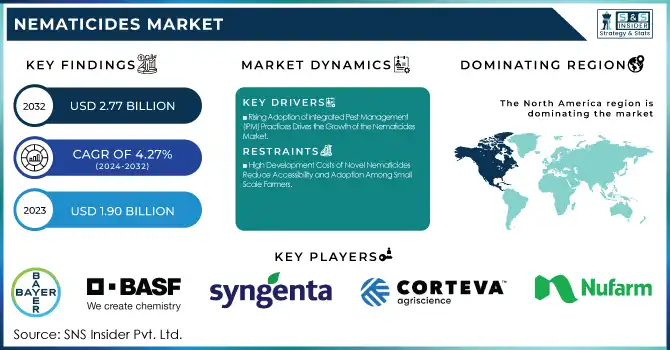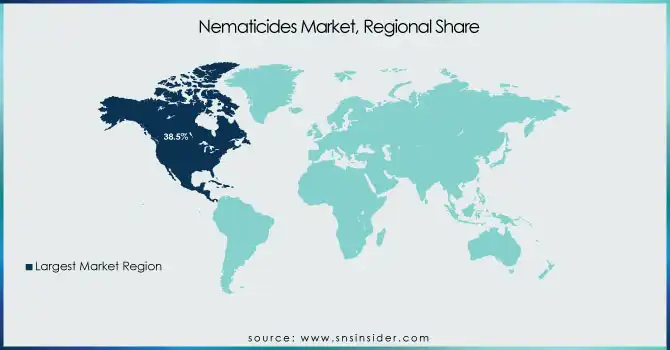Nematicides Market Report Scope & Overview:
The Nematicides Market Size was valued at USD 1.90 Billion in 2023 and is expected to reach USD 2.77 Billion by 2032, growing at a CAGR of 4.27% over the forecast period of 2024-2032.

To Get more information on Nematicides Market - Request Free Sample Report
The Nematicides Market is evolving with advancements in sustainable pest control and shifting agricultural practices. Our report presents an in-depth pricing analysis, highlighting regional cost variations and market competitiveness. A thorough supply chain and distribution analysis uncovers key stakeholders and logistical trends. With rising investments, the funding landscape explores venture capital flows and government incentives. Innovation drives growth, and the research and development pipeline track technological advancements and novel formulations. Additionally, economic and policy impact analysis examines regulations and trade policies shaping market dynamics. Beyond industry trends, consumer education and awareness initiatives influence adoption. Our report encapsulates these critical aspects, offering a comprehensive perspective on the market’s evolution and opportunities.
Nematicides Market Dynamics
Drivers
-
Rising Adoption of Integrated Pest Management (IPM) Practices Drives the Growth of the Nematicides Market
The increasing shift toward Integrated Pest Management (IPM) strategies is significantly driving the demand for nematicides. Farmers and agribusinesses are focusing on sustainable pest control solutions to minimize crop damage while reducing reliance on synthetic chemicals. Nematicides play a crucial role in IPM programs by effectively managing harmful nematodes that affect root development and overall plant health. As concerns over pesticide resistance and soil degradation grow, the adoption of targeted nematicides within IPM frameworks has surged. Additionally, government initiatives promoting eco-friendly agricultural practices and the implementation of stricter regulations on broad-spectrum pesticides have encouraged farmers to integrate nematicides into their crop protection strategies. The increased awareness of the economic impact of nematode infestations, particularly in high-value crops such as fruits, vegetables, and commercial plantations, further fuels the market. With ongoing research and technological advancements, nematicides are becoming more precise and effective, ensuring minimal environmental impact while maximizing agricultural productivity.
Restraints
-
High Development Costs of Novel Nematicides Reduce Accessibility and Adoption Among Small-Scale Farmers
The research and development of new nematicides involve high costs, posing a major restraint to market growth. Developing effective and environmentally safe nematicides requires extensive field trials, toxicology studies, and regulatory approvals, leading to high upfront investments. These costs are ultimately reflected in product pricing, making nematicides less affordable for small-scale farmers in developing regions. Additionally, the shift toward biological nematicides, while promising, requires advanced biotechnological research, further increasing development expenses. The lack of widespread awareness and technical knowledge among farmers regarding proper nematicide application methods also limits market penetration. Without significant subsidies or financial support programs, small and medium-scale farmers struggle to adopt advanced nematicide solutions, restricting market growth potential.
Opportunities
-
Expansion of Precision Agriculture Technologies Enhances the Effectiveness and Targeted Application of Nematicides
The integration of precision agriculture technologies is revolutionizing nematicide application methods, presenting a lucrative growth opportunity. Innovations such as drone-based pesticide spraying, remote sensing, and soil health monitoring enable farmers to optimize nematicide usage, reducing costs and environmental impact. Site-specific application methods ensure that nematicides are applied precisely where nematode infestations occur, enhancing efficiency and minimizing wastage. Data-driven decision-making through AI-powered analytics also allows for predictive nematode management, improving crop protection outcomes. The growing adoption of precision farming tools, particularly in developed regions, is expected to drive demand for advanced nematicides tailored for smart agricultural systems.
Challenge
-
Limited Awareness Among Farmers About Nematode Management Restricts the Widespread Adoption of Nematicides
Despite the economic impact of nematode infestations, many farmers remain unaware of the importance of proactive nematode management, hindering market expansion. Smallholder farmers, particularly in developing regions, often lack access to diagnostic tools to identify nematode-related crop damage, leading to delayed or improper treatment. The misconception that traditional pest control methods can effectively manage nematode populations further restricts nematicide adoption. Additionally, limited technical knowledge regarding proper nematicide application, dosage, and compatibility with other crop protection measures reduces the effectiveness of these products. Addressing this challenge requires extensive farmer education programs, government-led awareness initiatives, and training on integrated nematode management strategies.
Nematicides Market Segmental Analysis
By Type
Chemical nematicides dominated the Nematicides Market in 2023, holding a 72.5% market share. Among chemical nematicides, fumigants emerged as the leading subsegment, accounting for a significant market share due to their high efficacy in controlling nematodes. The dominance of chemical nematicides is primarily attributed to their immediate and broad-spectrum action against nematode infestations in key crops such as corn, soybean, and vegetables. Organizations like the United States Environmental Protection Agency (EPA) continue to regulate chemical nematicides, ensuring their safe usage while maintaining their availability in the market. Additionally, the European Food Safety Authority (EFSA) has been revising regulations to balance nematicide effectiveness with environmental concerns. Companies like Corteva Agriscience, Syngenta, and Bayer have expanded their chemical nematicide portfolios, driving growth in this segment.
By Crop Type
Field crops dominated the Nematicides Market in 2023, holding a 30.2% market share. The widespread cultivation of crops such as wheat, corn, soybeans, and rice make them highly susceptible to nematode infestations, necessitating the use of nematicides. Countries such as the United States, Brazil, and India have reported increasing nematode-related yield losses, prompting government initiatives for better pest management strategies. For instance, the United States Department of Agriculture (USDA) has emphasized integrated nematode control measures for major field crops. The growing demand for high-yielding, pest-resistant crops has further fueled the adoption of nematicides in large-scale commercial farming.
By Formulation
Granular formulations dominated the Nematicides Market in 2023, holding a 36.2% market share. Granular nematicides are widely preferred due to their ease of application, controlled release, and reduced risk of leaching into groundwater. The ability of granular formulations to provide long-lasting protection against nematodes in crops such as corn, potatoes, and sugar beets has increased their adoption. Regulatory bodies, including the Environmental Protection Agency (EPA) and the Food and Agriculture Organization (FAO), have encouraged the use of safer granular formulations over liquid fumigants due to environmental concerns. Companies such as FMC Corporation and Bayer AG have been investing in granular nematicide innovations to enhance their efficacy and expand their market reach.
By Nematode Type
Root-knot nematodes dominated the Nematicides Market in 2023, holding a 55.4% market share. These nematodes pose a significant threat to a wide range of crops, including tomatoes, carrots, soybeans, and cotton, causing extensive yield losses. The increasing prevalence of root-knot nematodes in major agricultural economies, including the United States, Brazil, and China, has driven the demand for effective nematicide solutions. The International Institute of Tropical Agriculture (IITA) has highlighted the economic impact of root-knot nematodes, emphasizing the need for targeted nematicide applications. Additionally, rising temperatures and soil conditions favourable for nematode proliferation have contributed to their dominance in the market.
By Mode of Application
Drenching dominated the Nematicides Market in 2023, holding a 30.1% market share. This method is preferred for its direct application to the soil and plant roots, ensuring effective nematode control. Drenching is widely used in high-value crops such as fruits, vegetables, and ornamental plants, where precise nematode management is crucial. Governments and research institutions, including the Indian Council of Agricultural Research (ICAR), have promoted soil drenching methods as part of sustainable pest control practices. Additionally, advancements in bio-nematicides have further increased the adoption of drenching as an efficient and eco-friendly application method.
Nematicides Market Regional Outlook
North America dominated the Nematicides Market in 2023, holding a market share of 38.5%. The region's dominance is driven by large-scale commercial farming, high nematode infestation levels, and strong regulatory support for nematicide adoption. The United States is the leading country, accounting for a substantial share due to its extensive agricultural land dedicated to crops like corn, soybean, and potatoes, which are highly susceptible to nematodes. The United States Department of Agriculture (USDA) has consistently emphasized the need for effective nematode management, leading to increased demand for both chemical and biological nematicides. In 2023, the EPA approved new bio-based nematicides to reduce environmental impact while maintaining efficiency. Canada also plays a key role, with rising nematode issues in wheat and potato farming, prompting the adoption of safer, long-lasting nematicide solutions. The presence of major nematicide manufacturers, such as Corteva Agriscience, Bayer, and Syngenta, has further contributed to market expansion in the region.
On the other hand, Asia Pacific emerged as the fastest-growing region in the Nematicides Market, with a significant growth rate in the forecast period. The region's rapid growth is fueled by increasing awareness of nematode-related yield losses, government initiatives to improve agricultural productivity, and the rising adoption of biological nematicides. China is the leading market, driven by its large-scale vegetable and fruit production, where nematodes significantly impact crop yields. The Chinese Ministry of Agriculture and Rural Affairs has introduced policies encouraging the use of biopesticides, including bio-nematicides, to ensure sustainable farming practices. India is another major contributor, with nematode infestations in crops like tomatoes, sugarcane, and rice leading to a surge in nematicide demand. The Indian Council of Agricultural Research (ICAR) reported a 15–20% crop loss due to nematodes, pushing farmers to adopt nematicides aggressively. Additionally, emerging economies like Vietnam, Indonesia, and Thailand are experiencing increased nematicide adoption as part of integrated pest management (IPM) programs.

Get Customized Report as per Your Business Requirement - Enquiry Now
Key Players
-
BASF SE (Velum, Nemasphere)
-
Bayer AG (Velum Prime, Monceren)
-
Corteva Agriscience (Salibro, Vydate)
-
Syngenta AG (Tervigo, Clariva)
-
FMC Corporation (Rugby, Presence)
-
UPL Limited (VAMOS, Phoskill)
-
American Vanguard Corporation (Counter, Nemacur)
-
Nufarm (Trunemco, Thor)
-
ADAMA Agricultural Solutions Ltd. (Nimitz, Custodia)
-
Valent BioSciences LLC (DiTera, MeloCon)
-
Isagro S.p.A (Biox-M, Remedier)
-
Marrone Bio Innovations (Majestene, Grandevo)
-
Certis Biologicals (MeloCon, Cordon)
-
Tessenderlo Kerley Inc. (NovaSource) (Enphase, Telone)
-
PI Industries (Nemacel, Fostera)
-
Albaugh LLC (Oxamyl, Agri-Mek)
-
Chr. Hansen (Nemix, VectoLex)
-
Ishihara Sangyo Kaisha, Ltd. (Lance, Hachi-Hachi)
-
Valent U.S.A. LLC (DiTera, Sevin)
-
Vive Crop Protection (AZterknot, Fenprote)
Recent Highlights
-
September 2023: Bayer introduced Velum Rise, a dual-action nematicide and fungicide, and Emesto Complete, a seed treatment for potatoes, to protect crops from nematodes and diseases while enhancing yields
-
September 2023: Corteva launched Reklemel, a targeted nematicide with a favorable safety profile, offering effective control of nematodes in vegetables and fruits while supporting sustainable farming.
| Report Attributes | Details |
|---|---|
| Market Size in 2023 | USD 1.90 Billion |
| Market Size by 2032 | USD 2.77 Billion |
| CAGR | CAGR of 4.27% From 2024 to 2032 |
| Base Year | 2023 |
| Forecast Period | 2024-2032 |
| Historical Data | 2020-2022 |
| Report Scope & Coverage | Market Size, Segments Analysis, Competitive Landscape, Regional Analysis, DROC & SWOT Analysis, Forecast Outlook |
| Key Segments | •By Type (Chemical [Fumigants, Organophosphates, Carbamates, Non-Fumigant Nematicides, Others], Biological [Microbials, Biochemical, Macrobials, Bionematicides]) •By Crop Type (Field Crops, Horticultural Crops, Commercial Crops, Turf & Ornamental Crops, Protected Cultivation / Greenhouse Crops, Others) •By Formulation (Granular, Liquid, Water-Dispersible Powder (WDP), Emulsifiable Concentrates (EC), Gels & Pastes, Others) •By Nematode Type (Root-Knot Nematodes, Cyst Nematodes, Lesion Nematodes, Others) •By Mode of Application (Drenching, Soil Dressing, Seed Treatment, Fumigation, Others) |
| Regional Analysis/Coverage | North America (US, Canada, Mexico), Europe (Eastern Europe [Poland, Romania, Hungary, Turkey, Rest of Eastern Europe] Western Europe] Germany, France, UK, Italy, Spain, Netherlands, Switzerland, Austria, Rest of Western Europe]), Asia Pacific (China, India, Japan, South Korea, Vietnam, Singapore, Australia, Rest of Asia Pacific), Middle East & Africa (Middle East [UAE, Egypt, Saudi Arabia, Qatar, Rest of Middle East], Africa [Nigeria, South Africa, Rest of Africa], Latin America (Brazil, Argentina, Colombia, Rest of Latin America) |
| Company Profiles | BASF SE, Bayer AG, Corteva Agriscience, Syngenta AG, FMC Corporation, UPL Limited, American Vanguard Corporation, Nufarm, ADAMA Agricultural Solutions Ltd., Valent BioSciences LLC and other key players |

